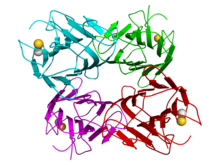Reviewer: S. Randhawa, M.D., Allergist/Immunologist and Assistant Professor at LSU (Shreveport) Department of Allergy and Immunology
A mitogen is a chemical substance that encourages a cell to commence cell division, triggering mitosis. A mitogen is usually a protein.
The most commonly used mitogens in laboratory medicine are:
| Name | Acts upon T cells? | Acts upon B cells? |
| phytohaemagglutinin (PHA) | yes | no |
| concanavalin A (conA) | yes | no |
| lipopolysaccharide (LPS) | no | yes |
| pokeweed mitogen (PWM) | yes | yes |
Lipopolysaccharide toxin (LPS) from gram-negative bacteria is thymus independent. LPS may directly activate B cells. Staphylococcus aureus Cowan strain stimulates only B cells.
Mnemonic
B
Bacterial products - LPS, Staphylococcus aureus Cowan (SAC)
B cell stimulation
Pokeweed stimulates both T cells and B cells (mnemonic: "weed is everywhere").
Lectins are sugar-binding proteins which are highly specific for their sugar moieties (Latin legere, "to select") http://bit.ly/3wgXl5

Crystallographic structure of a tetramer of concanavalin A. Image source: Wikipedia, public domain.
Concanavalin A is a lectin protein, binds specifically to glycoproteins - widely used in labs to characterize glycoproteins. http://bit.ly/ZEtKR
Concanavalin A is a lymphocyte mitogen along with phytohaemagglutinin (PHA) and pokeweed (PWM) http://bit.ly/15jH9T

Pokeweed (PWM). Image source: Wikipedia, GNU Free Documentation License.
Pokeweed mitogen (PWM) is derived from Phytolacca americana, considered a major pest by farmers http://bit.ly/sqVrD
References
Mitogen. Wikipedia.
Pokeweed mitogen (PWM) stimulates B and T lymphocytes, phytohemagglutinin (PHA) and concanavalin A stimulates T cells, and LPS and SAC stimulate B lymphocytes.
Lectins are sugar-binding proteins which are highly specific for their sugar moieties (Latin legere, "to select") http://bit.ly/3wgXl5

Crystallographic structure of a tetramer of concanavalin A. Image source: Wikipedia, public domain.
Concanavalin A is a lectin protein, binds specifically to glycoproteins - widely used in labs to characterize glycoproteins. http://bit.ly/ZEtKR
Concanavalin A is a lymphocyte mitogen along with phytohaemagglutinin (PHA) and pokeweed (PWM) http://bit.ly/15jH9T

Pokeweed (PWM). Image source: Wikipedia, GNU Free Documentation License.
Pokeweed mitogen (PWM) is derived from Phytolacca americana, considered a major pest by farmers http://bit.ly/sqVrD
References
Mitogen. Wikipedia.
Pokeweed mitogen and Staphylococcus aureus Cowan I induced immunoglobulin A synthesis by lymphocytes of IgA deficient blood donors. K Oen, M L Schroeder, and D Krzekotowska. Clin Exp Immunol. 1985 November; 62(2): 387–396.
Related:
Published: 05/05/2010
Related:
Published: 05/05/2010
Updated: 08/28/2010
No comments:
Post a Comment